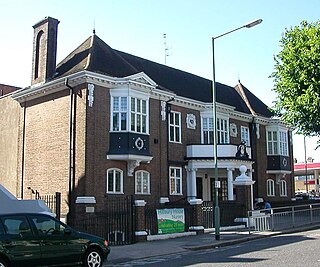This article needs additional citations for verification .(December 2012) |
| |||
|---|---|---|---|
| Buildings and structures +... |
The year 1762 in architecture involved some significant events.
This article needs additional citations for verification .(December 2012) |
| |||
|---|---|---|---|
| Buildings and structures +... |
The year 1762 in architecture involved some significant events.


The Palace of Placentia, also known as Greenwich Palace, was an English royal residence that was initially built by prince Humphrey, Duke of Gloucester, in 1443. Over the centuries it took several different forms, until turned into a hospital in the 1690s. The palace was a place designed for pleasure, entertainment and an escape from the city. It was located at Greenwich on the south bank of the River Thames, downstream from London.

Egyptian Revival is an architectural style that uses the motifs and imagery of ancient Egypt. It is attributed generally to the public awareness of ancient Egyptian monuments generated by Napoleon's conquest of Egypt and Admiral Nelson's defeat of the French Navy at the Battle of the Nile in 1798. Napoleon took a scientific expedition with him to Egypt. Publication of the expedition's work, the Description de l'Égypte, began in 1809 and was published as a series through 1826. The size and monumentality of the façades discovered during his adventure cemented the hold of Egyptian aesthetics on the Parisian elite. However, works of art and architecture in the Egyptian style had been made or built occasionally on the European continent since the time of the Renaissance.
This is a timeline of architecture, indexing the individual year in architecture pages. Notable events in architecture and related disciplines including structural engineering, landscape architecture, and city planning. One significant architectural achievement is listed for each year.
The year 1902 in architecture involved some significant events.
The year 1868 in architecture involved some significant events.
The year 1887 in architecture involved some significant architectural events and new buildings.
The year 1764 in architecture involved some significant events.
The year 1858 in architecture involved some significant events.
The year 1857 in architecture involved some significant events.

Princes Road Synagogue, officially Liverpool Old Hebrew Congregation, is an Orthodox Jewish congregation and synagogue, located on Princes Road in the Toxteth district of Liverpool, England, in the United Kingdom. The congregation was formed in c. 1780 and worships in the Ashkenazi rite.
The year 1904 in architecture involved some significant architectural events and new buildings.
The year 1770 in architecture involved some significant events.
The year 1760 in architecture involved some significant events.
Events from the year 1753 in Great Britain.

Henry Currey (1820–1900) was an English architect and surveyor.
Thomas Lainson, FRIBA was a British architect. He is best known for his work in the East Sussex coastal towns of Brighton and Hove, where several of his eclectic range of residential, commercial and religious buildings have been awarded listed status by English Heritage. Working alone or in partnership with two sons as Lainson & Sons, he designed buildings in a wide range of styles, from Neo-Byzantine to High Victorian Gothic; his work is described as having a "solid style, typical of the time".

Ralli Hall is a community centre, events venue, theatre stage, business hub and impressive main hall in Hove, part of the English coastal city of Brighton and Hove. Built in 1913 as a memorial to Stephen Ralli, a member of a wealthy Greek family who had donated money to many causes throughout Brighton and Hove, it was used for about 60 years as a church hall linked to Hove's parish church. The Brighton & Hove Jewish community subsequently bought it, and in 1976 it came back into use as a community and social centre for Jewish and other groups. The Wrenaissance-style brick structure occupies a prominent corner site in a conservation area and provides a visual contrast to the older villas around it. English Heritage has listed the building at Grade II for its architectural and historical importance.
The following is a timeline of the history of London, the capital of England and the United Kingdom.